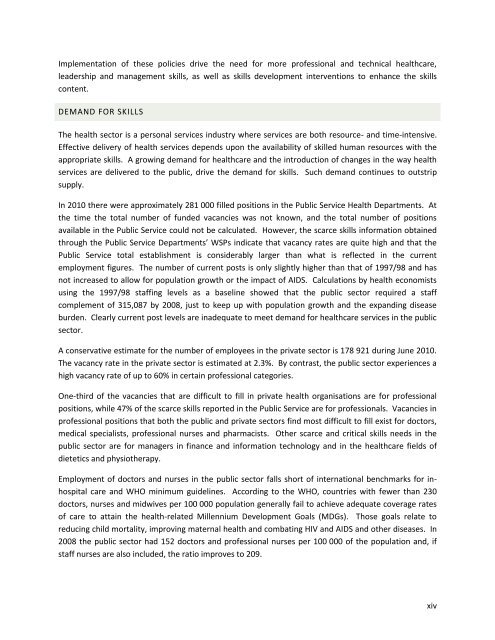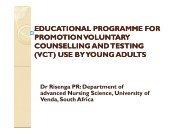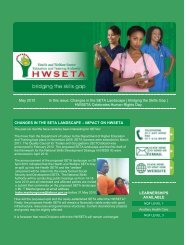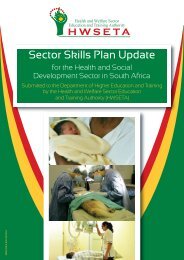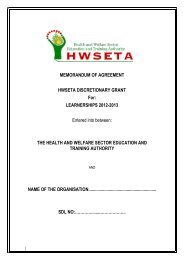sector skills plan for the health sector in south africa
sector skills plan for the health sector in south africa
sector skills plan for the health sector in south africa
You also want an ePaper? Increase the reach of your titles
YUMPU automatically turns print PDFs into web optimized ePapers that Google loves.
Implementation of <strong>the</strong>se policies drive <strong>the</strong> need <strong>for</strong> more professional and technical <strong>health</strong>care,<br />
leadership and management <strong>skills</strong>, as well as <strong>skills</strong> development <strong>in</strong>terventions to enhance <strong>the</strong> <strong>skills</strong><br />
content.<br />
DEMAND FOR SKILLS<br />
The <strong>health</strong> <strong>sector</strong> is a personal services <strong>in</strong>dustry where services are both resource- and time-<strong>in</strong>tensive.<br />
Effective delivery of <strong>health</strong> services depends upon <strong>the</strong> availability of skilled human resources with <strong>the</strong><br />
appropriate <strong>skills</strong>. A grow<strong>in</strong>g demand <strong>for</strong> <strong>health</strong>care and <strong>the</strong> <strong>in</strong>troduction of changes <strong>in</strong> <strong>the</strong> way <strong>health</strong><br />
services are delivered to <strong>the</strong> public, drive <strong>the</strong> demand <strong>for</strong> <strong>skills</strong>. Such demand cont<strong>in</strong>ues to outstrip<br />
supply.<br />
In 2010 <strong>the</strong>re were approximately 281 000 filled positions <strong>in</strong> <strong>the</strong> Public Service Health Departments. At<br />
<strong>the</strong> time <strong>the</strong> total number of funded vacancies was not known, and <strong>the</strong> total number of positions<br />
available <strong>in</strong> <strong>the</strong> Public Service could not be calculated. However, <strong>the</strong> scarce <strong>skills</strong> <strong>in</strong><strong>for</strong>mation obta<strong>in</strong>ed<br />
through <strong>the</strong> Public Service Departments’ WSPs <strong>in</strong>dicate that vacancy rates are quite high and that <strong>the</strong><br />
Public Service total establishment is considerably larger than what is reflected <strong>in</strong> <strong>the</strong> current<br />
employment figures. The number of current posts is only slightly higher than that of 1997/98 and has<br />
not <strong>in</strong>creased to allow <strong>for</strong> population growth or <strong>the</strong> impact of AIDS. Calculations by <strong>health</strong> economists<br />
us<strong>in</strong>g <strong>the</strong> 1997/98 staff<strong>in</strong>g levels as a basel<strong>in</strong>e showed that <strong>the</strong> public <strong>sector</strong> required a staff<br />
complement of 315,087 by 2008, just to keep up with population growth and <strong>the</strong> expand<strong>in</strong>g disease<br />
burden. Clearly current post levels are <strong>in</strong>adequate to meet demand <strong>for</strong> <strong>health</strong>care services <strong>in</strong> <strong>the</strong> public<br />
<strong>sector</strong>.<br />
A conservative estimate <strong>for</strong> <strong>the</strong> number of employees <strong>in</strong> <strong>the</strong> private <strong>sector</strong> is 178 921 dur<strong>in</strong>g June 2010.<br />
The vacancy rate <strong>in</strong> <strong>the</strong> private <strong>sector</strong> is estimated at 2.3%. By contrast, <strong>the</strong> public <strong>sector</strong> experiences a<br />
high vacancy rate of up to 60% <strong>in</strong> certa<strong>in</strong> professional categories.<br />
One-third of <strong>the</strong> vacancies that are difficult to fill <strong>in</strong> private <strong>health</strong> organisations are <strong>for</strong> professional<br />
positions, while 47% of <strong>the</strong> scarce <strong>skills</strong> reported <strong>in</strong> <strong>the</strong> Public Service are <strong>for</strong> professionals. Vacancies <strong>in</strong><br />
professional positions that both <strong>the</strong> public and private <strong>sector</strong>s f<strong>in</strong>d most difficult to fill exist <strong>for</strong> doctors,<br />
medical specialists, professional nurses and pharmacists. O<strong>the</strong>r scarce and critical <strong>skills</strong> needs <strong>in</strong> <strong>the</strong><br />
public <strong>sector</strong> are <strong>for</strong> managers <strong>in</strong> f<strong>in</strong>ance and <strong>in</strong><strong>for</strong>mation technology and <strong>in</strong> <strong>the</strong> <strong>health</strong>care fields of<br />
dietetics and physio<strong>the</strong>rapy.<br />
Employment of doctors and nurses <strong>in</strong> <strong>the</strong> public <strong>sector</strong> falls short of <strong>in</strong>ternational benchmarks <strong>for</strong> <strong>in</strong>hospital<br />
care and WHO m<strong>in</strong>imum guidel<strong>in</strong>es. Accord<strong>in</strong>g to <strong>the</strong> WHO, countries with fewer than 230<br />
doctors, nurses and midwives per 100 000 population generally fail to achieve adequate coverage rates<br />
of care to atta<strong>in</strong> <strong>the</strong> <strong>health</strong>-related Millennium Development Goals (MDGs). Those goals relate to<br />
reduc<strong>in</strong>g child mortality, improv<strong>in</strong>g maternal <strong>health</strong> and combat<strong>in</strong>g HIV and AIDS and o<strong>the</strong>r diseases. In<br />
2008 <strong>the</strong> public <strong>sector</strong> had 152 doctors and professional nurses per 100 000 of <strong>the</strong> population and, if<br />
staff nurses are also <strong>in</strong>cluded, <strong>the</strong> ratio improves to 209.<br />
xiv


